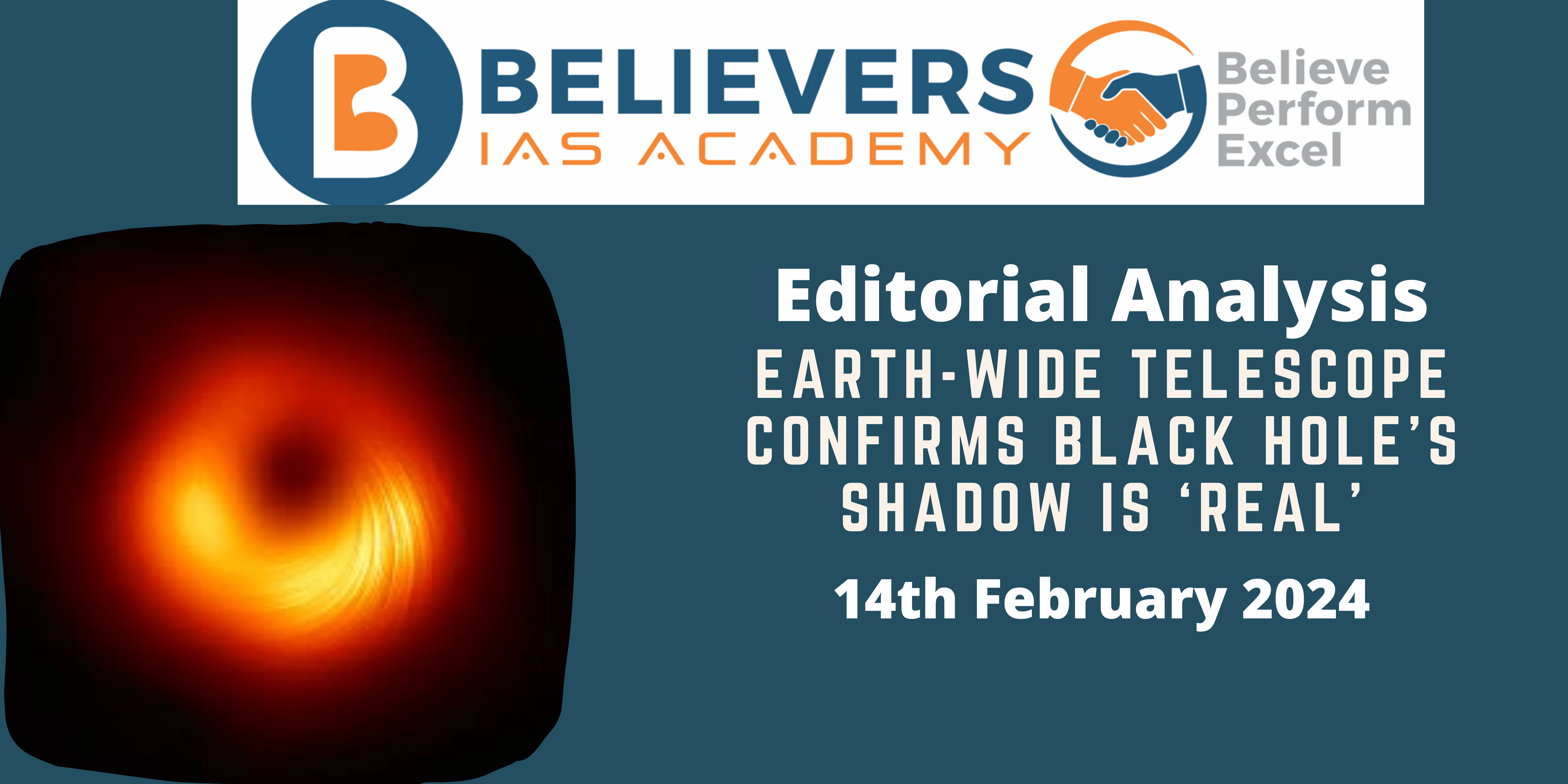Earth-wide telescope confirms black hole’s shadow is ‘real’
Context:
Scientists have released new findings about a massive black hole located 53 million lightyears away, which was first captured by the Event Horizon Telescope (EHT) in 2017.
- These findings offer deeper insights into the black hole’s structure, particularly around its event horizon, providing further evidence for the existence of black holes and confirming predictions of Einstein’s general theory of relativity.
Relevance:
GS-03 (Space technology)
Prelims:
Ultramassive Black Hole, Gravitational lensing, Black Hole, Hubble Space Telescope, Theory of Relativity.
Dimensions from the Article:
- What is a Black hole?
- Understanding the Black Hole’s Structure
- The Collaborative Effort of the EHT
- Insights from Data Analysis
- Gravitational Lensing Phenomenon
- Evolution of the Accretion Disk and Jet
What is a Black hole?
- A black hole is a region of spacetime where gravity is so strong that nothing, including light and other electromagnetic waves, has enough energy to escape it.
- Einstein’s theory of general relativity predicts that a sufficiently compact mass can deform spacetime to form a black hole.
- The boundary of no escape is called the event horizon.
- A black hole has a great effect on the fate and circumstances of an object crossing it, but it has no locally detectable features according to general relativity.
- In many ways, a black hole acts like an ideal black body, as it reflects no light.
- Quantum field theory in curved spacetime predicts that event horizons emit Hawking radiation, with the same spectrum as a black body of a temperature inversely proportional to its mass. This temperature is of the order of billionths of a kelvin for stellar black holes, making it essentially impossible to observe directly.
- The presence of a black hole can be inferred through its interaction with other matter and with electromagnetic radiation such as visible light. Any matter that falls toward a black hole can form an external accretion disk heated by friction, forming quasars, some of the brightest objects in the universe.
Understanding the Black Hole’s Structure:
- The recent publication by EHT researchers sheds light on the intricate details surrounding the event horizon of the colossal black hole.
- Unlike previous observations that revealed the black hole’s shadow, this latest endeavor delves into the formation of a distinct ring encircling the event horizon.
- This achievement marks a significant milestone in our quest to comprehend the enigmatic nature of black holes.
The Collaborative Effort of the EHT:
- The Event Horizon Telescope operates as a global collaboration, employing an array of radio telescopes worldwide.
- Through a technique known as very-long baseline interferometry, these telescopes synchronize their observations to study celestial objects collectively.
- By enhancing the telescope array and expanding its coverage, scientists have achieved a remarkable improvement in resolution, enabling them to capture finer details of the black hole’s structure.
Insights from Data Analysis:
- The meticulous analysis of data collected during the 2018 observation campaign has unveiled substantial changes in the closure phase, indicating shifts in the configuration of the black hole.
- Employing advanced computational models based on Einstein’s theory of general relativity, researchers have gained valuable insights into the complex dynamics near the event horizon, including gravitational lensing effects.
Gravitational Lensing Phenomenon:
- The observations confirm the presence of an asymmetric ring structure surrounding the black hole, akin to observing a grain of sand from a considerable distance.
- This phenomenon, known as gravitational lensing, occurs when the immense gravitational pull of the black hole distorts spacetime, bending light rays and magnifying the images of surrounding objects.
- The brightness asymmetry observed in the ring further underscores the intricate interplay between the black hole’s rotation and the surrounding spacetime.
Evolution of the Accretion Disk and Jet:
- Researchers have also observed intriguing changes in the orientation of the black hole’s accretion disk and the associated jet of high-energy particles.
- These variations, attributed to the spin of the black hole, offer tantalizing clues about the underlying mechanisms driving the formation and evolution of these structures.
- By unraveling these complexities, scientists hope to gain a deeper understanding of the fundamental physics governing black hole dynamics.
Way Forward and Conclusion:
- The latest findings from the EHT collaboration represent a significant leap forward in our quest to unravel the mysteries of black holes. By harnessing cutting-edge technology and international collaboration, scientists have pushed the boundaries of observational astronomy, providing unprecedented insights into the nature of these cosmic giants.
- As we look ahead, the future holds promising opportunities for further exploration and discovery. The upcoming “movie project” slated for 2026 aims to track the black hole’s brightness changes over an extended period, offering a dynamic glimpse into its evolving behavior.
- Such endeavors underscore the importance of continued investment in observational astronomy, paving the way for new breakthroughs and discoveries on the frontiers of astrophysics.



